Good morning, and welcome back to Masterpiece Theater here on Hipsters of the Coast for another edition of Parallels, a brand new series exploring Upper Deck’s Marvel Masterpieces from 2016-2020.
My last project was diving deep into the most recent Marvel Masterpieces 2020 set by Dave Palumbo, and as I neared its completion, I became curious about how his work would connect to the previous two “modern” Masterpiece sets that came before him. The 2016 set was done by Joe Jusko, artist of the first Marvel Masterpieces set in 1992. In 2018 wildly popular Italian comic artist Simone Bianchi followed in his footsteps, and completed his own Marvel Masterpieces set with new characters, new Battle Spectra scenes, and an entirely different stylistic take on the Marvel universe.
Each of the three sets are completely unique, and puts an artist’s style in the full spotlight. Jusko’s look is classic comic book, with all the muscle, color, and vibrancy of the sets from the 1990s, but reimagined for a new century. Bianchi is more contemporary: darker and grittier with bold blacks and colored outlines to make his characters distinct and out of this world. Palumbo falls somewhere in the middle: his big brushstrokes give a painterly feel to the genre, and bring a balance to the modern Masterpieces. His rendition especially is something that trading cards have never seen.
Across the three sets 2016-2020, there are 42 characters that were painted into each set at least once, and several characters that have multiple appearances within a given year. In total we’ll look at more than 175 artworks from the last three iterations of Marvel Masterpieces, compare and contrast each artist’s creation, and learn some pretty cool stuff directly from the artist’s themselves along the way. This series isn’t about picking the best work, but rather talking about why each is a Masterpiece in its own right, and how these works function as a family of premier illustrations both within and across their respective sets.
This is the final part of a three-part mini-series looking at the X-Men. First came the ladies, followed by the men, and now it’s time to explore the art and history of their fearless leader. This is Parallels: Wolverine!
Wolverine: A Brief History
Wolverine first appeared in Marvel comics in the last panel of The Incredible Hulk #180, and would make his first full appearance in the following issue, The Incredible Hulk #181 in November of 1974:
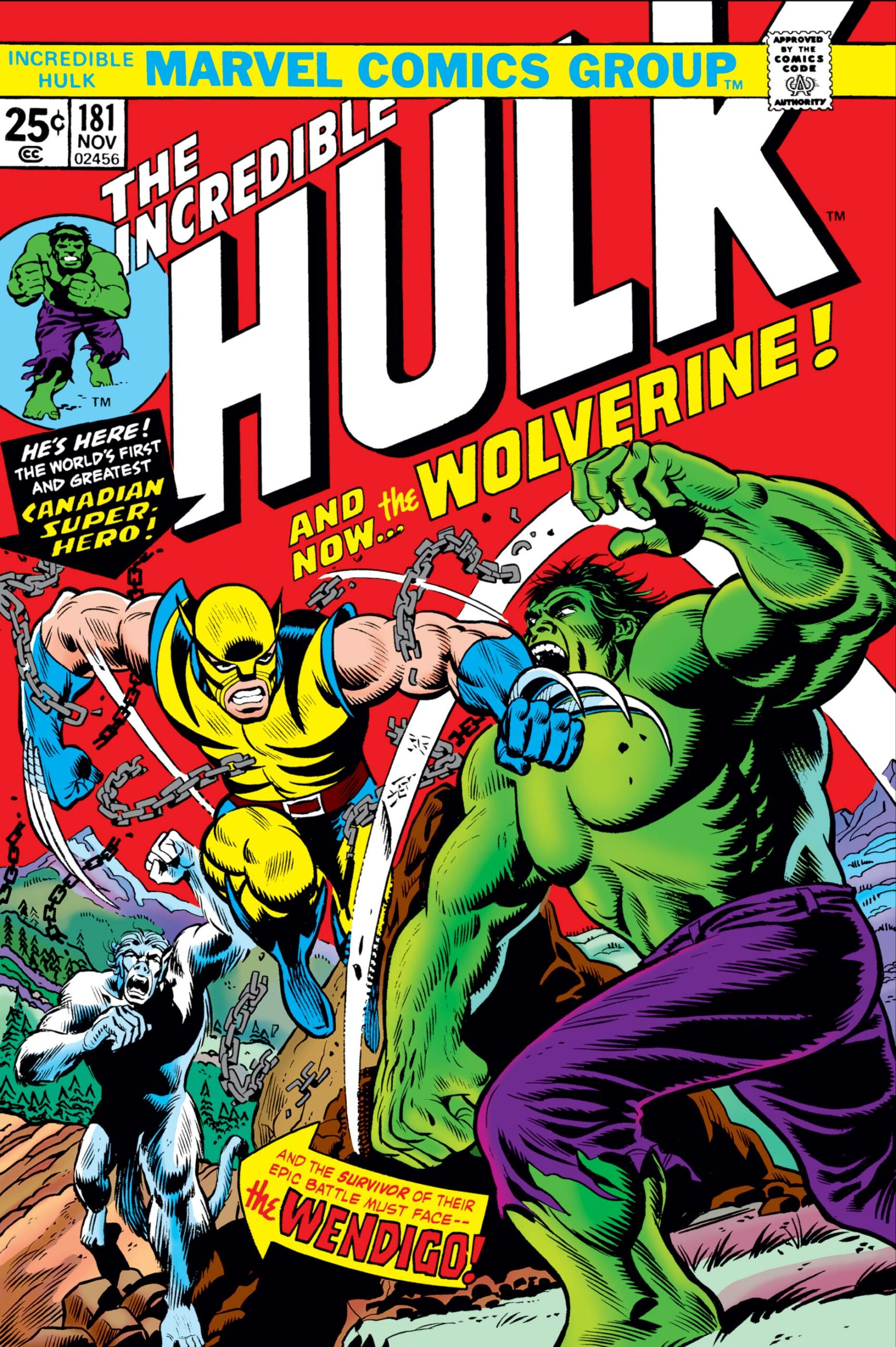
The Incredible Hulk #181 (November 1974). Image: Marvel.
He was the combination brain-child of then Marvel editor-in-chief Roy Thomas, writer Len Wein, and Marvel art director John Romita, Sr. That first cover you see above was penciled by Herb Trimpe, with some alterations by Romita, who is also responsible for designing the character’s first costume.
A mutant with indestructible, adamantium-infused bones and retractable claws of the same medium, James Howlett aka Logan has filled the pages of the stories of the X-Men, Alpha Flight, and the Avengers for more than forty years, becoming the face of the X-Men throughout hundreds of different comic issues and dozens of diverging story lines. He is one of, if not the most, popular Marvel character across all superhero teams and franchises
Wolverine appears on seven cards of his own across the three Masterpiece sets: three in 2016, two in 2018, and two in 2020. Let’s dig in.
Wolverine in Marvel Masterpieces
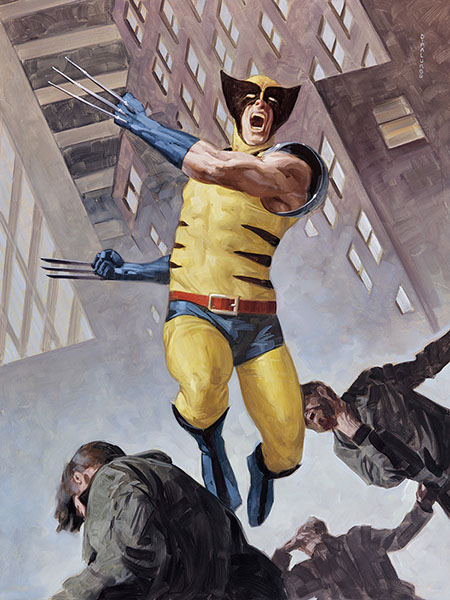
Wolverine (Base) by Dave Palumbo, 2020.
We’ll begin with Wolverine’s most recent iteration, the Tier 4 Base card from last year’s Marvel Masterpieces 2020. This is one of the signature cards of the set, and perhaps the most desirable to collectors of all 135 that were created, even as of the writing of this article.
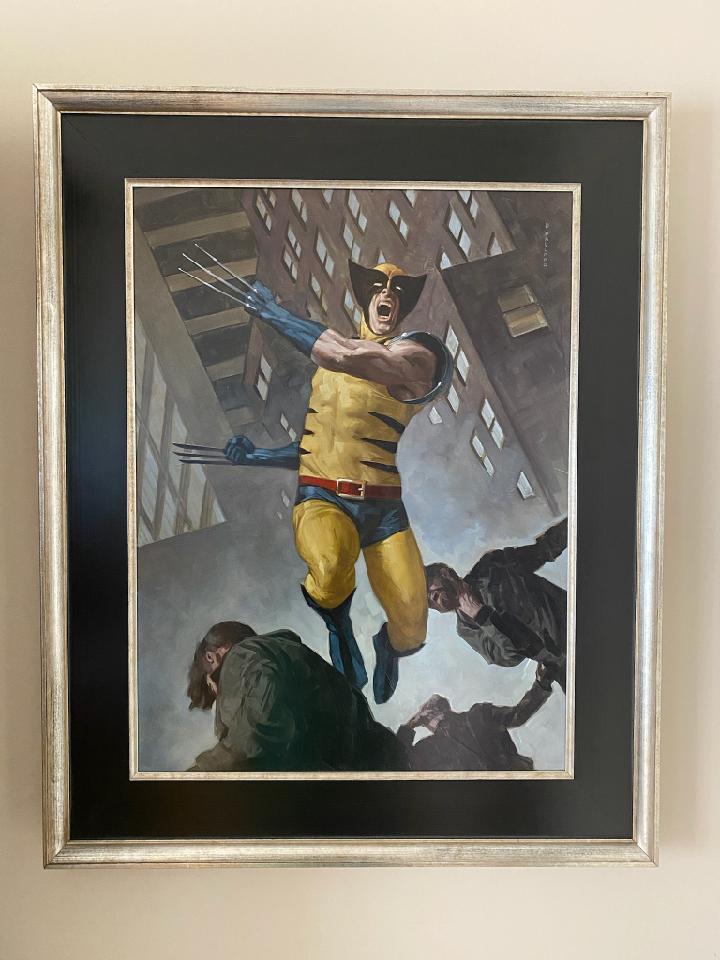
The final artwork, which was an ePack redemption, in its forever home. Private Collection of Sidney Blumenthal.
A strong and recurring theme of the 2020 set is Palumbo’s capturing of movement, his putting these superheroes in action like tiny motion pictures. Wolverine is yet another perfect encapsulation, and when set to its associated song as Palumbo does, becomes especially entertaining. It’s a city street shootout at the O.K. Corral. Same end result, except claws instead of guns.
“Wolverine in Motion” is not exclusive to this card, however, and is also found in the form of something more affectionately known to fans as the “fastball special.”
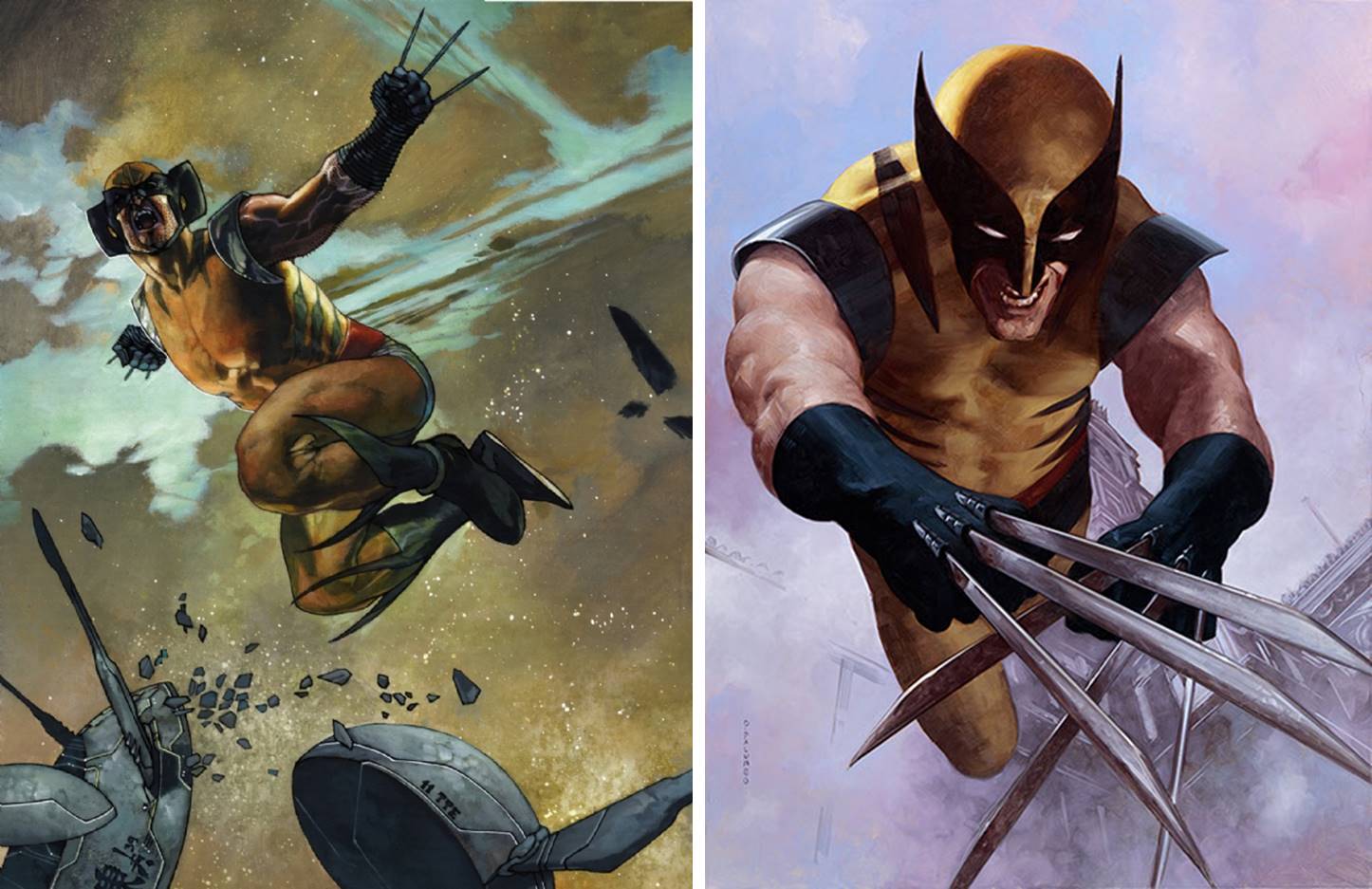
Left: Wolverine (Canvas Gallery) by Simone Bianchi, 2018. Right: Wolverine (Holofoil) by Dave Palumbo, 2020.
The “fastball special” was a move made famous and for the first time by Colossus and Wolverine in X-Men #100, and that’s very likely what we’re seeing here. In both works Wolverine kites through the air; we can’t see where he’s come from or where he’s going, only the business end of the adamantium claws and a face of pure purpose.
At the end of the ride, you come face to face with the man himself.
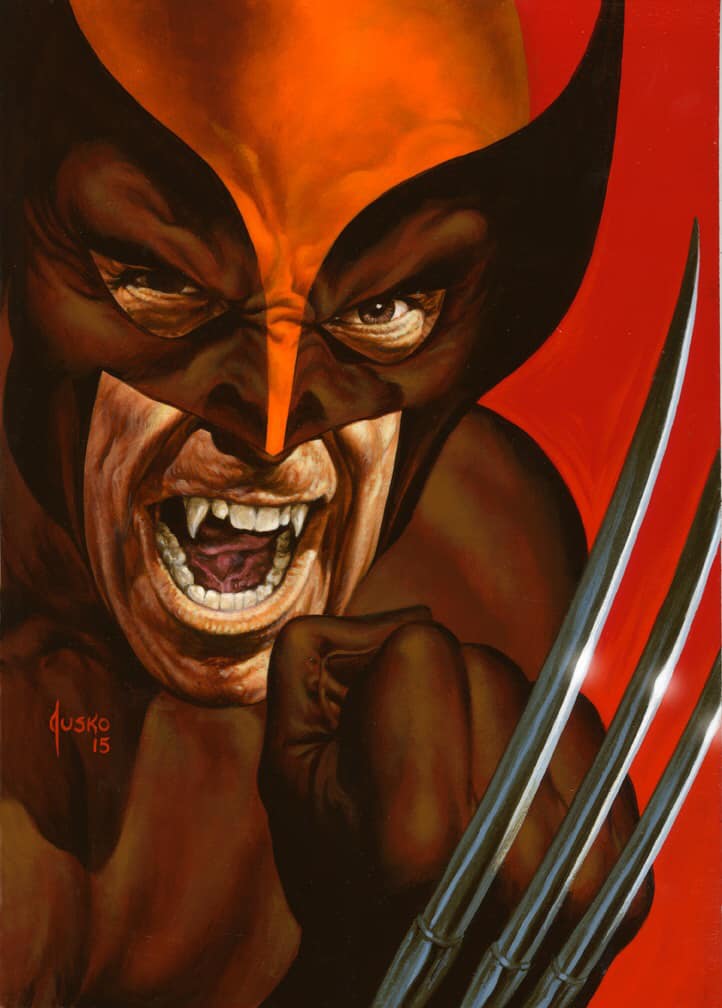
Wolverine (Canvas Gallery) by Joe Jusko, 2016.
This is the only portrait amongst the seven, one in a series of close-ups that Jusko did primarily for his Canvas Gallery subset back in 2016. Wolverine is shown in his brown and orange costume, and for the first time we really get to see his eyes. It’s one of the most intense works of any of the Marvel Masterpieces line, exuding vintage undertones and a pulp-fiction style to showcase the supermutant like no other.
Jusko’s other two works are much more similar to one another, and show us the hero as many of us 1990s kids grew up with him.
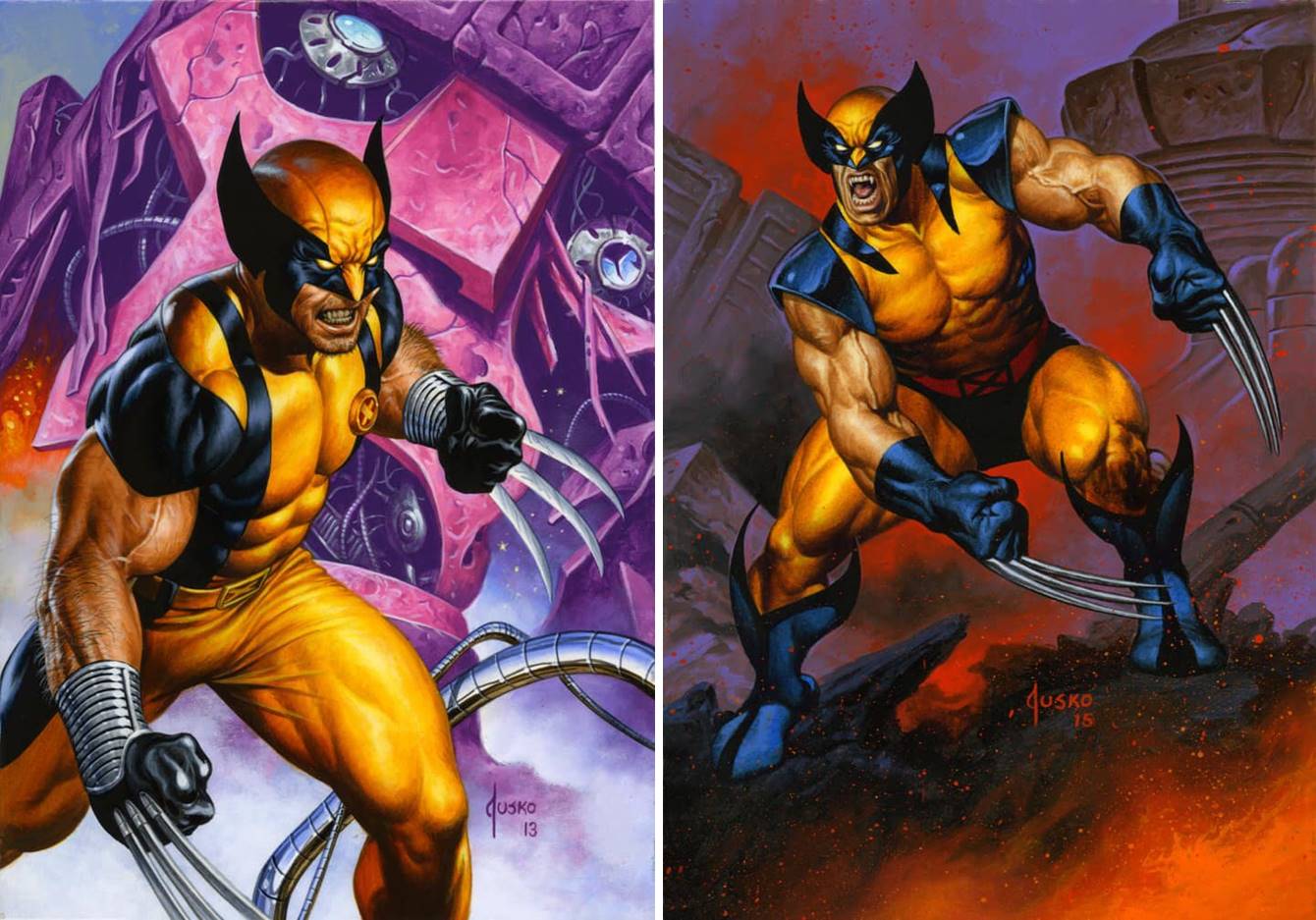
Left: Wolverine (Base) by Joe Jusko, 2016. Right: Wolverine (Holofoil) by Joe Jusko, 2016.
Here in the classic Yellow and Blue costume, this is how I met Wolverine, and how I still think of him today. Muscular, stubbled, and angry, he’s shown on the left post-battle with a decimated Sentinel behind him, and on the right, for the holofoil series, in similar circumstances. Destruction abounds.
Jusko mentions in his book that he “wanted to convey the impression that he’s only five feet tall and built like a fire hydrant” and that’s exactly the feeling we get, of solid, immovable strength. He also mentioned he wished he would have painted the head 5-10% larger, but didn’t realize it until the final stages of an already well-rendered face. As such he left as is, and the painting still successfully shows Wolverine as the brick house we know and love.
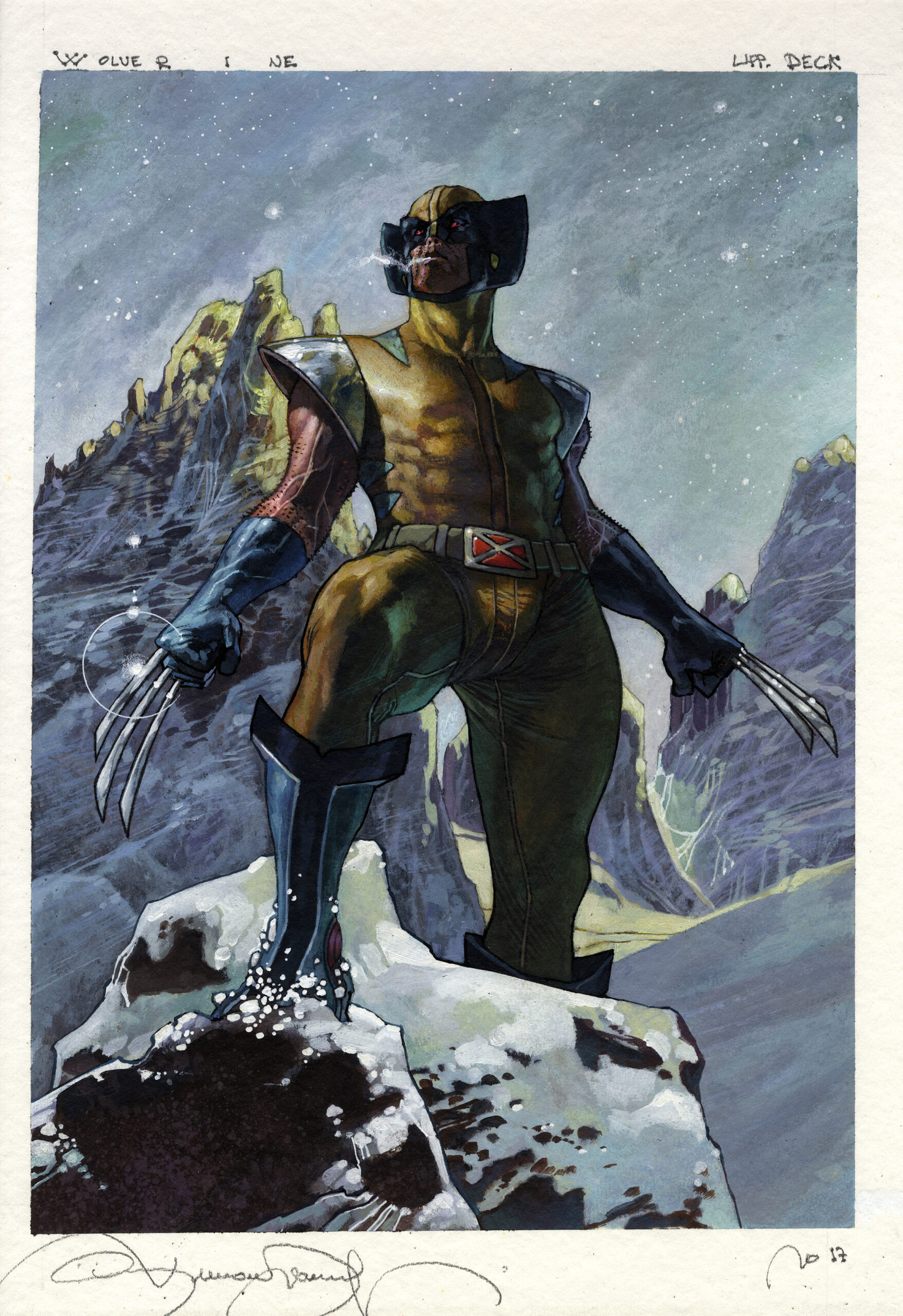
Wolverine (Base) by Simone Bianchi, 2018.
Our final work for today is I think my favorite Wolverine across the seven, perhaps because it feels like it’s a painting from 150 years ago while all at the same time being hugely current. Shown amongst the Canadian mountains, a red-eyed Wolverine emits a bit of breath-turned-steam as he summits the peak. The forward foot symbolizes not only exploration but triumph, and I’d wager something is cast down behind him we can’t see. There is a regality to this work and a playfulness all the same, a dichotomy between the serious and the sincere. It reminds me of Maximus in the 2000 film Gladiator:
“Are you not entertained?”
Wrapping Up
If the X-Men are one of the flagships of Marvel, then Wolverine is no doubt it’s captain. In these depictions he is both classic and contemporary, intense and intimate, wildly violent and wonderfully serene. When looked at on the whole, these seven works do well to capture the complexity that is the character of Logan, and work together to tell a complicated story that’s still being written to this day.
This concludes our X-Men miniseries in Parallels, and next time in Masterpiece Theater we’ll be jumping back into Marvel Masterpieces 2020 with a second Sketch Card Showcases, highlighting sketch cards and artists I’ve picked up since the last article. We’re also only a few weeks away from the first Marvel Unbound article that will look at the first quarter worth of work by set artist fred.ian!
In the meantime, you can keep up with all things Marvel Masterpieces 2020 by following me on Twitter. Feel free to ask questions or retweet to continue the conversation. Thanks and see you next time!
Donny Caltrider has been playing Magic since 2002 and collecting original Magic art since 2017. He has an M.A. in Museum Studies from Johns Hopkins University and enjoys telling stories about art, objects, and the intersection of fantasy with real-life. You can find him on Twitter talking about #mtgart, museums, and other #vorthos related goodness. Follow along and continue the conversation!

